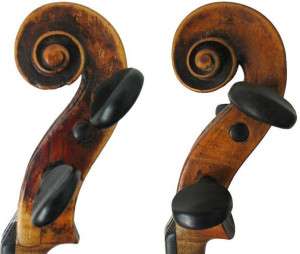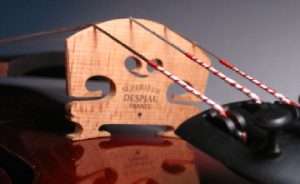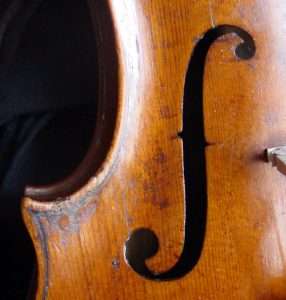
Violin – musical instrument
Contents
The violin is an oval-shaped bow-stringed musical instrument with equal recesses on the sides of the body. The sound emitted ( strength and timbre ) when playing an instrument is influenced by: the shape of the violin body, the material from which the instrument is made and the quality and composition of the varnish with which the musical instrument is coated.
Violin forms were established by the 16th century; famous manufacturers of violins, the Amati family, belong to this century and the beginning of the 17th century. Italy was famous for the production of violins. The violin has been a solo instrument since the XVII
Design
The violin consists of two main parts: the body and neck , along which the strings are stretched. The size of a full violin is 60 cm, weight – 300-400 grams, although there are smaller violins.
Frame
The body of the violin has a specific rounded shape. In contrast to the classical form of the case, the shape of the trapezoidal parallelogram is mathematically optimal with rounded notches on the sides, forming a “waist”. The roundness of the outer contours and the “waist” lines ensures the comfort of the Play, in particular in high positions. The lower and upper planes of the body – decks – are connected to each other by strips of wood – shells. They have a convex shape, forming “vaults”. The geometry of the vaults, as well as their thickness, its distribution to one degree or another determine the strength and timbre of the sound. A darling is placed inside the case, which communicates vibrations from the stand – through the top deck – to the bottom deck. Without it, the timbre of the violin loses its liveliness and fullness.
The strength and timbre of the sound of the violin is greatly influenced by the material from which it is made, and, to a lesser extent, the composition of the varnish. An experiment is known with the complete chemical removal of varnish from a Stradivarius violin, after which its sound did not change. The lacquer protects the violin from changing the quality of the wood under the influence of the environment and stains the violin with a transparent color from light golden to dark red or brown.
The bottom deck is made from solid maple wood (other hardwoods), or from two symmetrical halves.
The top deck is made from resonant spruce. It has two resonator holes – effs (from the name of the lowercase Latin letter F, which they look like). A stand rests on the middle of the upper deck, on which the strings, fixed on the string holder (under the fingerboard), rest. A single spring is attached to the top soundboard under the leg of the stand on the side of the G string — a longitudinally located wooden plank, which largely ensures the strength of the top soundboard and its resonant properties.
The shells unite the lower and upper decks, forming the side surface of the violin body. Their height determines the volume and timbre of the violin, fundamentally influencing the sound quality: the higher the shells, the muffled and softer the sound, the lower, the more piercing and transparent the upper notes. The shells are made, like the decks, from maple wood.
The corners on the sides serve to position the bow when playing. When the bow is pointed at one of the corners, the sound is produced on the corresponding string. If the bow is between two corners, the sound is played on two strings at the same time. There are performers who can produce sound on three strings at once, but for this you have to deviate from the rule of positioning the bow in the corners and change the configuration of the stand.ad

The darling is a round spacer made of spruce wood that mechanically connects the soundboards and transmits string tension and high-frequency vibrations to the bottom soundboard. Its ideal location is found experimentally, as a rule, the end of the homie is located under the leg of the stand on the side of the E string, or next to it. Dushka is rearranged only by the master, since its slightest movement significantly affects the sound of the instrument.
The neck , or tailpiece , is used to fasten the strings. Formerly made from hardwoods of ebony or mahogany (usually ebony or rosewood).respectively). Nowadays it is often made of plastics or light alloys. On the one hand, the neck has a loop, on the other – four holes with splines for attaching strings. The end of the string with a button (mi and la) is threaded into a round hole, after which, by pulling the string towards the neck, it is pressed into the slot. The D and G strings are often fixed in the neck with a loop passing through the hole. Currently, lever-screw machines are often installed in the neck holes, which greatly facilitate tuning. Serially produced light alloy necks with structurally integrated machines.
Loop made of thick string or steel wire. When replacing a strand loop larger than 2.2 mm in diameter with a synthetic one (2.2 mm diameter), a wedge must be inserted and a hole with a diameter of 2.2 must be re-drilled, otherwise the point pressure of the synthetic string may damage the wooden sub-neck.
A button is a head of a wooden peg inserted into a hole in the body, located on the opposite side of the neck, used to fasten the neck. The wedge is inserted into a conical hole corresponding to its size and shape, completely and tightly, otherwise cracking of the ring and shell is possible. The load on the button is very high, about 24 kg.
The stand is a support for the strings from the side of the body and transmits vibrations from them to the soundboards, directly to the top one, and to the bottom one through the darling. Therefore, the stand position affects the timbre of the instrument. It has been experimentally established that even a slight shift of the stand leads to a significant change in the instrument’s tuning due to a change in the scale and to some change in timbre – when shifted to the fretboard – the sound is muffled, from it – brighter. The stand raises the strings above the top sounding board to different heights for the possibility of playing on each of them with a bow, distributes them at a greater distance from one another on an arc of a larger radius than the nut, so that when playing on one string, the bow would not cling to the neighboring ones.
Vulture
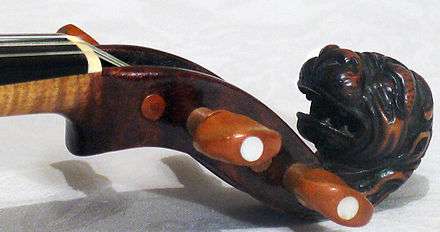
The neck of a violin is a long plank of solid hard wood (black ebony or rosewood), curved in cross section so that when playing on one string, the bow would not cling to adjacent strings. The lower part of the neck is glued to the neck, which passes into the head, consisting of a peg box and a curl.ad
The nut is an ebony plate located between the neck and the head, with slots for the strings. Slots in the nut distribute the strings evenly apart and provide clearance between the strings and the neck.
The neck is a semicircular detail that the performer covers with his hand during the Play, structurally unites the body of the violin, neck and head. The neck with the nut is attached to the neck from above.
The peg box is a part of the neck in which a slot is made frontally, two pairs of tuning pegs are inserted on both sides , with the help of which the strings are tuned. The pegs are conical rods. The rod is inserted into the conical hole in the peg box and adjusted to it – failure to comply with this condition may lead to the destruction of the structure. For tighter or smoother rotation, the pegs are pressed in or pulled out of the box, respectively, and for smooth rotation they must be lubricated with lapping paste (or chalk and soap). The pegs should not protrude much from the pegs box. The tuning pegs are usually made of ebony and are often decorated with mother-of-pearl or metal (silver, gold) inlays.
The curl has always served as something like a corporate brand – evidence of the taste and skill of the creator. Initially, the curl rather resembled a female foot in a shoe, over time, the similarity became less and less – only the “heel” is recognizable, the “toe” has changed beyond recognition. Some craftsmen replaced the curl with sculpture, like a viol, with a carved lion’s head, for example, as did Giovanni Paolo Magini (1580-1632). Masters of the XIX century, lengthening the fretboard of ancient violins, sought to preserve the head and curl as a privileged “birth certificate”.
Strings, tuning and setup of the violin
The strings run from the neck, through the bridge, over the surface of the neck, and through the nut to the pegs, which are wound around the headstock. String Composition:
- 1st – Mi of the second octave. The string is homogeneous in composition, sonorous brilliant timbre .
- 2nd – La of the first octave. A string with a core and braid, sometimes homogeneous in composition (“Thomastik”), soft matte timbre.
- 3rd – D of the first octave. String with a core and braid, soft matte tone.
- 4th – Salt of a small octave. A string with a core and braid, a harsh and thick timbre.
Setting up the violin
The A string is tuned by an A tuning fork or a piano . The remaining strings are tuned by ear in pure fifths : the Mi and Re strings from the La string, the Sol string from the Re string .
Violin construction:
The curl has always served as something like a corporate brand – evidence of the taste and skill of the creator. Initially, the curl was more like a female foot in a shoe, over time, the similarity became less and less.
Some masters replaced the curl with a sculpture, like a viola with a lion’s head, for example, as did Giovanni Paolo Magini (1580-1632).
The tuning pegs or peg mechanics are parts of the violin fittings, installed to tension the strings and tune the violin.
Fretboard – an elongated wooden part, to which the strings are pressed when playing to change the note.
A nut is a detail of string instruments that limits the sounding part of the string and raises the string above the fretboard to the required height. To prevent the strings from shifting, the nut has grooves corresponding to the thickness of the strings.
The shell is the side part of the body (bent or composite) of the music. tools.
Resonator F – holes in the form of the Latin letter “f”, which serve to amplify the sound.
History of the violin
The forerunners of the violin were the Arabic rebab, the Kazakh kobyz, the Spanish fidel, the British crotta, the merger of which formed the viola. Hence the Italian name for the violin violino , as well as the Slavonic a four-string instrument of the fifth order jig (hence the German name for the violin – geige ).
The struggle between the aristocratic viola and the folk violin, which lasted for several centuries, ended in victory for the latter. As a folk instrument, the violin became especially widespread in Belarus, Poland, Ukraine, Romania, Istria and Dalmatia. Since the second half of the 19th century, it has become widespread among the Tatars [3] . Since the 20th century, it has been found in the musical life of the Bashkirs [4] .
In the middle of the 16th century , the modern design of the violin developed in northern Italy . The right to be considered the inventor of the “aristocratic” violin of the modern type is disputed by Gasparo da Salo (d. 1609) from the city of Bresci and Andrea Amati [en] (d. 1577) – the founder of the Cremonese school [5] . Cremonese Amati violins, preserved from the 17th century, are distinguished by their excellent shape and excellent material. Lombardy was famous for the production of violins in the 18th century; violins produced by Stradivari and Guarneri are extremely highly valued . [6]Violins are made by violin makers.
“Family tree” of the origin of the modern violin.


The violin has been a solo instrument since the 17th century. The first works for violin are considered: “Romanesca per violino solo e basso” by Biagio Marini (1620) and “Capriccio stravagante” by his contemporary Carlo Farina. Arcangelo Corelli is considered the founder of artistic violin playing ; then follow Torelli and Tartini, as well as Locatelli (Corelli’s student who developed the bravura technique of violin playing), his student Magdalena Laura Sirmen (Lombardini), Nicola Matthijs, who created the violin school in Great Britain, Giovanni Antonio Piani.
Accessories and accessories
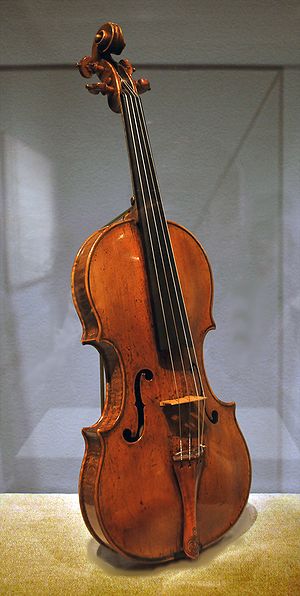

They play the violin with a bow, which is based on a wooden cane, passing from one side into the head, on the other a block is attached. A ponytail hair is pulled between the head and the block. The hair has keratin scales, between which, when rubbed, rosin is impregnated (impregnated), it allows the hair to cling to the string and produce sound.
There are other, less obligatory, accessories:
- The chinrest is designed for the convenience of pressing the violin with the chin. Lateral, middle and intermediate positions are selected from the violinist’s ergonomic preferences.
- The bridge is designed for the convenience of laying the violin on the collarbone. Mounted on the bottom deck. It is a plate, straight or curved, hard or covered with a soft material, wood, metal or plastic, with fasteners on both sides.
- Pickup devices are required to convert the mechanical vibrations of the violin into electrical ones (for recording, for amplifying or converting the sound of the violin using special devices). If the sound of a violin is formed due to the acoustic properties of the elements of its body, the violin is acoustic, if the sound is formed by electronic and electromechanical components, it is an electric violin, if the sound is formed by both components in a comparable degree, the violin is classified as semi-acoustic.
- The mute is a small wooden or rubber “comb” with two or three teeth with a longitudinal slot. It is put on top of the stand and reduces its vibration, so that the sound becomes muffled, “socky”. More often mute is used in orchestral and ensemble music.
- “Jammer” – a heavy rubber or metal mute used for homework, as well as for classes in places that do not tolerate noise. When using a jammer, the instrument practically ceases to sound and emits barely distinguishable pitch tones, sufficient for perception and control by the performer.
- Typewriter – a metal device consisting of a screw inserted into the neck hole, and a lever with a hook that serves to fasten the string, located on the other side. The machine allows finer tuning, which is most critical for mono-metallic strings with low stretch. For each size of the violin, a certain size of the machine is intended, there are also universal ones. They usually come in black, gold, nickel or chrome, or a combination of finishes. Models are available specifically for gut strings, for the E string. The instrument may not have machines at all: in this case, the strings are inserted into the neck holes. Installation of machines not on all strings is possible. Usually in this case, the machine is placed on the first string.
- Another accessory for the violin is a case or wardrobe trunk in which the instrument, bow and additional accessories are stored and carried.
Violin playing technique
The strings are pressed with four fingers of the left hand to the fretboard (the thumb is excluded). The strings are led with a bow in the right hand of the player.
Pressing the finger against the fretboard shortens the string, thereby raising the pitch of the string. Strings that are not pressed by a finger are called open strings and are denoted by zero.
The violin part is written in the treble clef.
The range of the violin is from the salt of a small octave to the fourth octave. Higher sounds are difficult.
From the semi-pressing of the string in certain places, harmonics are obtained . Some harmonic sounds go beyond the violin range indicated above.
The application of the fingers of the left hand is called fingering . The index finger of the hand is called the first, the middle finger is the second, the ring finger is the third, and the little finger is the fourth. A position is a fingering of four adjacent fingers spaced one tone or semitone apart. Each string can have seven or more positions. The higher the position, the more difficult it is. On each string, excluding fifths, they go mainly only up to the fifth position inclusive; but on the fifth or the first string, and sometimes on the second, higher positions are used – from the sixth to the twelfth.
The ways of conducting the bow have a great influence on the character, strength, timbre of the sound, and indeed on phrasing.
On a violin, you can normally take two notes simultaneously on adjacent strings ( double strings ), in exceptional cases – three (strong bow pressure is required), and not simultaneously, but very quickly – three ( triple strings ) and four. Such combinations, mostly harmonic, are easier to perform with empty strings and more difficult without them, and are usually used in solo works.
A very common orchestral tremolo technique is the rapid alternation of two sounds or the repetition of the same sound, creating the effect of trembling, trembling, flickering.
The technique of col legno, which means hitting the string with the shaft of the bow, causes a knocking, deathly sound, which is also used with great success by composers in symphonic music.
In addition to playing with a bow, they use touching the strings with one of the fingers of the right hand – pizzicato (pizzicato).
To weaken or muffle the sound, they use a mute – a metal, rubber, rubber, bone or wooden plate with recesses in the lower part for the strings, which is attached to the top of the stand or filly.
The violin is easier to play in those keys that allow the greatest use of empty strings. The most convenient passages are those that are composed of scales or their parts, as well as arpeggios of natural keys.
It is difficult to become a violinist in adulthood (but possible!), since finger sensitivity and muscle memory are very important for these musicians. The sensitivity of the fingers of an adult is much less than that of a young person, and muscle memory takes longer to develop. It is best to learn to play the violin from the age of five, six, seven, perhaps even from an earlier age.
10 Famous violinists
- Arcangelo Corelli
- Antonio Vivaldi
- Giuseppe Tartini
- Jean-Marie Leclerc
- Giovanni Batista Viotti
- Ivan Evstafievich Khandoshkin
- Niccolo Paganini
- Ludwig Spohr
- Charles-Auguste Bériot
- Henri Vietain
Recording and performance
Notation


The violin part is written in the treble clef. The standard violin range is from the salt of a small octave to the fourth octave. Higher sounds are difficult to perform and are used, as a rule, only in solo virtuoso literature, but not in orchestral parts.
Hand position
The strings are pressed with four fingers of the left hand to the fretboard (the thumb is excluded). The strings are led with a bow in the right hand of the player.
By pressing with a finger, the length of the oscillating region of the string decreases, due to which the frequency increases, that is, a higher sound is obtained. Strings that are not pressed with a finger are called open strings and are indicated by zero when indicating the fingering.
From touching the string with almost no pressure at the points of multiple division, harmonics are obtained . Many harmonics are far out of the standard violin range in pitch.
The arrangement of the fingers of the left hand on the fretboard is called fingering . The index finger of the hand is called the first, the middle finger is the second, the ring finger is the third, and the little finger is the fourth. A position is a fingering of four adjacent fingers spaced one tone or semitone apart. Each string can have seven or more positions. The higher the position, the more difficult it is to play cleanly in it. On each string, excluding the fifth (the first string), they go mainly only up to the fifth position inclusive; but on the first string, and sometimes on the second, they use higher positions – up to the twelfth.
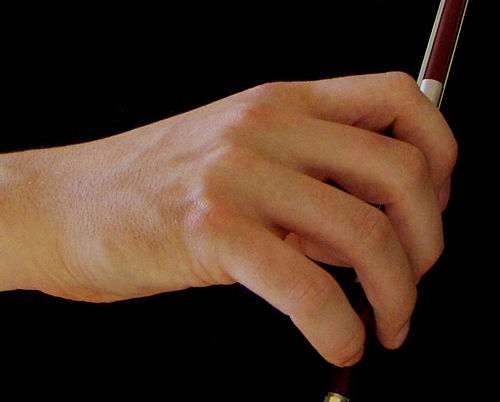

There are at least three ways to hold the bow [7] :
- The old (“German”) way , in which the index finger touches the bow stick with its lower surface, approximately against the fold between the nail phalanx and the middle; fingers tightly closed; the thumb is opposite the middle; the hair of the bow is taut moderately.
- A new (“Franco-Belgian”) way , in which the index finger touches the cane at an angle with the end of its middle phalanx; there is a large gap between the index and middle fingers; the thumb is opposite the middle; tightly taut bow hair; inclined position of the cane.
- The newest (“Russian”) method , in which the index finger touches the cane from the side with a fold between the middle phalanx and metacarpal; deeply covering the cane with the middle of the nail phalanx and forming an acute angle with it, it seems to direct the conduct of the bow; there is a large gap between the index and middle fingers; the thumb is opposite the middle; loosely taut bow hair; straight (not inclined) position of the cane. This way of holding the bow is the most appropriate for achieving the best sound results with the least expenditure of energy.
Holding the bow has a great influence on the character, strength, timbre of the sound, and in general on phrasing. On a violin, you can normally take two notes simultaneously on neighboring strings ( double notes ), in exceptional cases – three (strong bow pressure is required), and not simultaneously, but very quickly – three ( triple notes ) and four. Such combinations, mostly harmonic, are easier to perform on open strings, and are usually used in solo works.


Watch this video on YouTube
Left hand position
- “Open strings” – the fingers of the left hand do not clamp the strings, that is, the violin extracts four notes separated by fifths: g, d 1 , a 1 , e 2 (salt of a small octave, re, la of the first octave, mi of the second octave).
- First position – the fingers of the left hand, except for the thumb, can clamp the string in four places, separated from each other and from the open string by a diatonic tone. Together with open strings, they form a 20-ton range of sounds from the note Sol of a small octave to C of the second octave.
First position
The thumb is directed at the player, forming a “shelf” on which the violin neck lies – it performs only a supporting function. The other fingers of the left hand are located on top, pressing the strings without holding the neck. The left hand has a total of seven “basic” positions, which are based on the following:
- The fingers are located in the position corresponding to the white keys of the piano;
- The fingers do not move along the neck;
- The distance between adjacent fingers on the same string is a tone or a semitone;
- The distance between the fourth finger on the larger string and the first finger (extreme workers) on the smaller string is one tone.
Specifically, the first position looks like this:


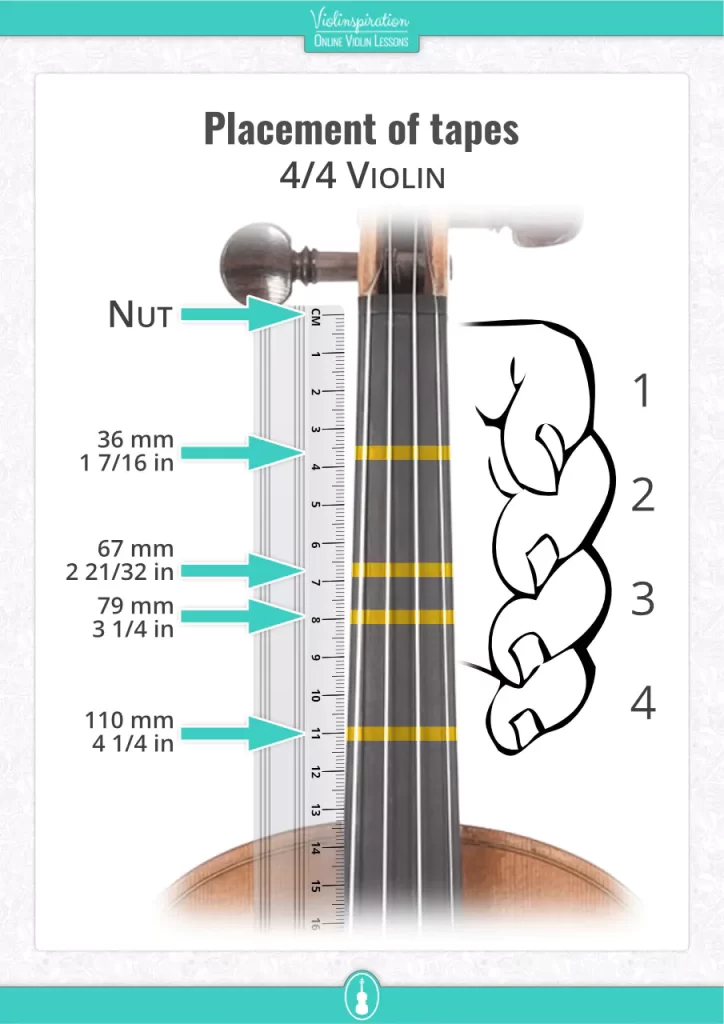

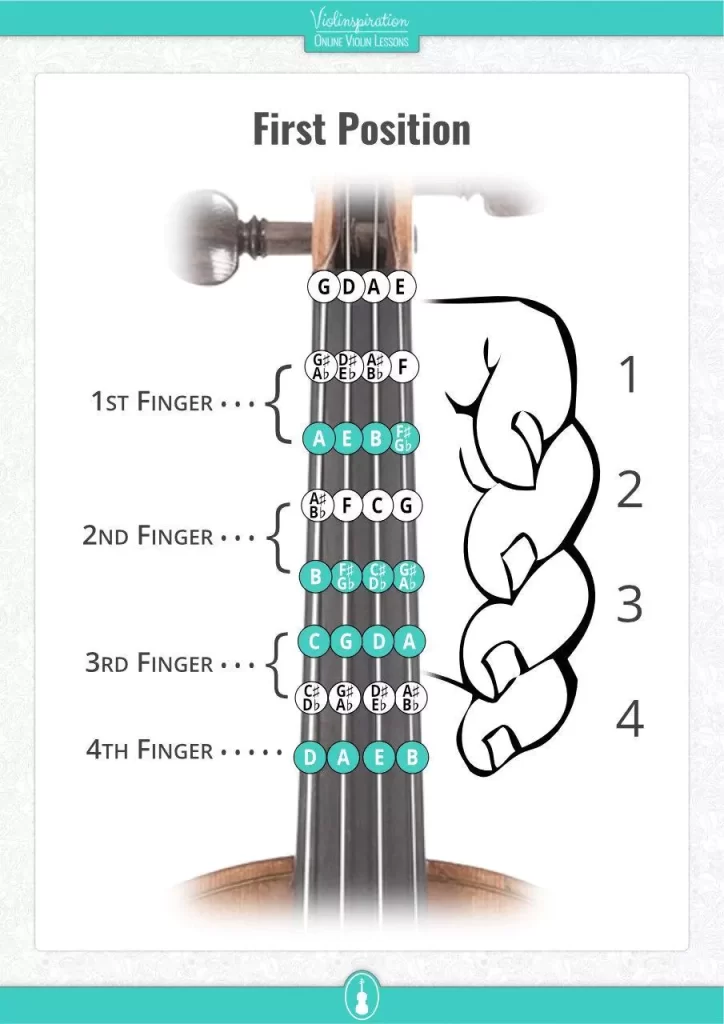

Basic tricks:
- Détaché – each note is played by a separate movement of the bow, by changing its direction;
- Martelé – a stroke performed by a push of the bow, in which the length of the sound itself is much shorter than the decay period of the sonority;
- Staccato down and up with the bow – movement of the bow with a stop;
- Staccato volant is a type of staccato. When playing, the bow jumps, breaking away from the strings;
- Spiccato – jerky and rebounding stroke, weighted staccato with additional shoulder movement;
- Sautillé – a rebounding touch, lightened and accelerated by Spiccato;
- Ricochet-saltato – a stroke performed by hitting the hair of a raised bow on a string, as a rule, it is performed by a continuous group;
- Tremolo – multiple rapid repetition of one sound or a quick alternation of two non-adjacent sounds, two consonances ( intervals , chords ), a single sound and consonance.
- Legato – a connected performance of sounds, in which there is a smooth transition from one sound to another, there is no pause between sounds.
- Col legno – hitting the string with the shaft of the bow. Causes a thumping, dead sound, which is also used with great success by composers in symphonic music.
In addition to playing with a bow, they use touching the strings with one of the fingers of the right hand ( pizzicato ). There is also pizzicato with the left hand, which is used mainly in solo literature.
There is also a special way to isolate the overtone from the composition of the timbre of a sounding string – harmonica. Natural harmonics are performed by touching the string at the points of a multiple division of its length – by 2 (the pitch of the string rises by an octave), by 3, by 4 (two octaves), etc. Artificial ones, in the same way, divide the one pressed below with the first finger in the usual way string. Depending on the setting of the 1st and 4th fingers of the left hand, the flageolets can be fourth, fifth.
Differences
The violin is divided into classical and folk (depending on the people and their cultural and musical traditions and preferences). Classical and folk violins differ little from each other and are not alien musical instruments. The differences between classical violin and folk violin are perhaps only in the field of application (academic and folklore) and in their cultural preferences and traditions.
Functions of the violin as a solo instrument in musical groups
The Baroque period is the period of the dawn of the violin as a professional instrument. Due to the closeness of the sound to the human voice and the ability to produce a strong emotional impact on the listeners, the violin became the leading instrument. The sound of the violin was set higher than other instruments, which made it a more suitable instrument for playing the melodic line. When playing the violin, a virtuoso musician is able to perform fast and difficult fragments of works ( passages ).
The violins also make up a significant part of the orchestra, in which the musicians are divided into two groups, known as the first and second violins. Most often, the melodic line is dedicated to the first violins, while a group of the second ones perform an accompanying or imitating function.
Sometimes the melody is entrusted not to the whole group of violins, but to the solo violin. Then the first violinist, the accompanist, plays the melody. Most often, this is necessary to give the melody a special color, delicate and fragile. The solo violin is most often associated with the lyrical image.
The string quartet in its original form consists of two violins (musicians playing the first and second violin parts), a viola and a cello. Like an orchestra, most often the first violin plays the leading role, but in general, each instrument can have solo moments.
Playing the violin is one of the main nominations in the competition program of the youth Delphic Plays of Russia.
Sources
- Violin // Encyclopedic Dictionary of Brockhaus and Efron : in 86 volumes (82 volumes and 4 additional). – St. Petersburg. , 1890-1907.
- K. Flesh, The Art of Violin Playing (vol. 1) – Music, M., 1964.
- K. Flesh, The Art of Violin Playing (vol. 2) – Classics-XXI, M., 2007.
- L. Auer, Violin Playing as I Teach It (1920); in Russian per. – My School of Violin Playing , L., 1933;
- V. Mazel, Violinist and his hands (right) – Composer, St. Petersburg, 2006.
- V. Mazel, Violinist and his hands (left) – Composer, St. Petersburg, 2008.
- A. Tsitsikyan “Armenian bow art”, Yerevan, 2004.
- Banin A. A. Russian instrumental music of the folklore tradition . Moscow, 1997.
FAQ about Violin
How does the violin affect the human body?
The violin gives a person a powerful imagination and flexibility of the mind, increases the ability to creative insights, and develops intuition. This is not a mysticism, this fact is scientifically explained.
Why is it so difficult to play the violin?
The violin has no frets, like other string tools, so such self -confidence will evaporate. The left hand will have to work, relying only on the musician himself. The violin does not tolerate haste, therefore, before the first performance of a musical work, a lot of time can pass.
How much on average costs a violin?
Prices vary from 70 USD to 15000 USD. How much does a violin for beginners cost not to spoil your hearing and study normally? First, evaluate your budget. If you can easily afford to buy a tool at a price of 500$.



